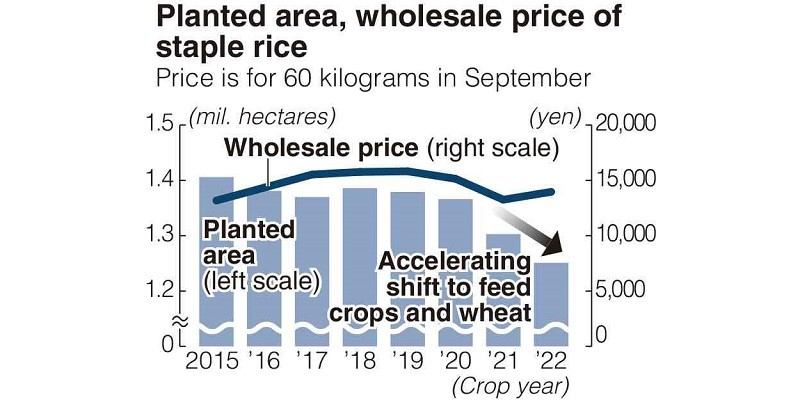
Farmer Atsunori Suzuki checks a corn field in Sakura, Chiba Prefecture, in October.
7:00 JST, November 23, 2022
Domestic farmers are increasingly shifting from planting rice to growing corn and other grains for livestock feed, following a surge in the price of imported grains amid Russia’s invasion of Ukraine.
Sluggish demand for rice in the domestic market is also accelerating the change, and the government is considering expanding support for farmers who switch from rice to other crops.
Atsunori Suzuki, 49, cultivates about 40 hectares of rice paddies in Sakura, Chiba Prefecture. Last year, Suzuki began large-scale production of corn for livestock feed in some of his paddies that previously produced so-called staple rice.
Staple rice is handled separately from rice used for industrial purposes, such as ingredients for sake, miso and crackers.
Suzuki initially made the shift because harvesting corn involved a lighter workload than staple rice. However, the poultry farms to which he sells his corn have recently been calling for increased production, and Suzuki plans to double his planted area of corn next year.
“It’s better to grow what people want than staple rice that is often overstocked,” he said.
Soaring global grain prices have pushed up demand for domestically produced corn — mixed feed for livestock cost ¥100,186 per ton in August, up 22.7% from the same month last year.
Japan has traditionally relied on imports for 70 to 80% of its feed. However, poultry farmers and others are increasing their purchases of domestically produced feed, which has stable prices.
Govt to expand support
According to the Agriculture, Forestry and Fisheries Ministry, Japan had 1,251,000 hectares planted with staple rice in the 2022 crop year, down 52,000 hectares from the 2021 crop year. Demand is weakening due to the declining birthrate and changing dietary habits.
Wholesale prices for the 2022 crop rose for the first time in three years, but they are still below the level before the COVID-19 pandemic.

In contrast, the planted area of corn and rice used for feed in the 2022 crop year increased for the second consecutive year, up 37,000 hectares from the year before to 549,000 hectares. Moves to replace rice paddies with fields producing wheat, vegetables and fruits are also expanding rapidly.
In its comprehensive economic stimulus package compiled last month, the government proposed strengthening domestic production of feed crops, including corn, as well as production of wheat and soybeans.
The ministry plans to provide subsidies for five years to farmers who turn rice paddies into fields to produce such crops. To fund the program, ¥25 billion was allocated in the second supplementary budget proposal for fiscal 2022.
"Business" POPULAR ARTICLE
-

Tokyo Economic Security Forum to Hold Inaugural Meeting Amid Tense Global Environment
-

Keidanren Chairman Yoshinobu Tsutsui Visits Kashiwazaki-Kariwa Nuclear Power Plant; Inspects New Emergency Safety System
-

Imports of Rare Earths from China Facing Delays, May Be Caused by Deterioration of Japan-China Relations
-

University of Tokyo Professor Discusses Japanese Economic Security in Interview Ahead of Forum
-

Japan Pulls out of Vietnam Nuclear Project, Complicating Hanoi’s Power Plans
JN ACCESS RANKING
-

Tokyo Economic Security Forum to Hold Inaugural Meeting Amid Tense Global Environment
-

Keidanren Chairman Yoshinobu Tsutsui Visits Kashiwazaki-Kariwa Nuclear Power Plant; Inspects New Emergency Safety System
-

Imports of Rare Earths from China Facing Delays, May Be Caused by Deterioration of Japan-China Relations
-

University of Tokyo Professor Discusses Japanese Economic Security in Interview Ahead of Forum
-

Japan Pulls out of Vietnam Nuclear Project, Complicating Hanoi’s Power Plans




























